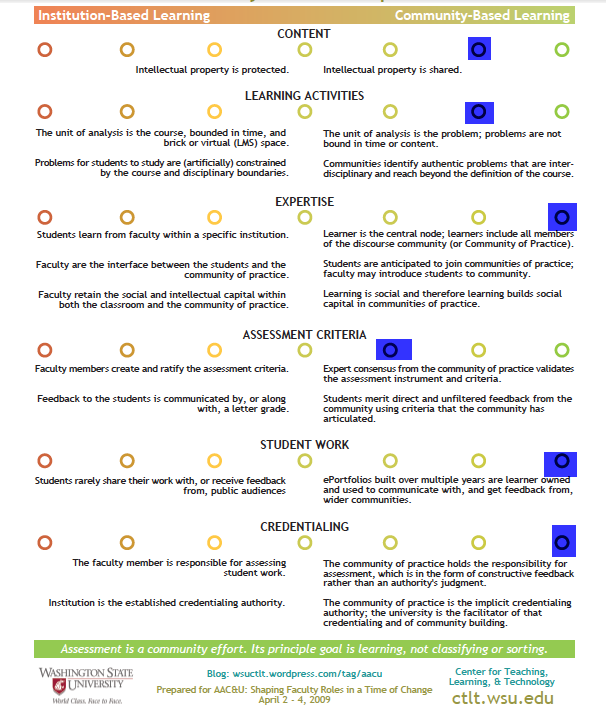Rudy Leon, University of Nevada-Reno http://campusguides.unr.edu/rudy_leon
A New culture of learning for a world of constant change, JSB talk at IL, changed the way she thought about librarianship.
He talked about dispositions, participatory learning, knowledge was making, learning was making, challenged her to look at the core of librarianship.
Reading/listening to Henry Jenkins, Howard Rheingold, John Paul Gee, Buffy Hamilton, David Lankes, Char Booth, Barbara Fister
What’s a library? Using the lens of these people? Making… Creating…
Inspiration to end product, the library is your inspiration for that. Creating, engineering of a canoe? Happend in a library.
Librarianship is going through a very stressful change.
More about people, services, interactions than a book warehouse
Defining terms:
participatory learning: (Howard Rheingold & Henry Jenkins) — relative low barrier to enagement; strong support for creating and sharing; informal mentorship; experiences passed along; social connection; people believe others will care about what they created. This is a part of the new, hidden curriculum.
dispositions:Â foster the idea that people will engage in certain ways with certain things. Curiosity is one example. Work skills have a half-life of five years. Build into future workers, tendencies that they are going to want to learn, engage, be lifelong learners, because that’s the only way they will succeed. Teach them how to want to keep learning.
making: Hacker Scouts story on NPRÂ taking it out of the computer into the world, that’s research. Making (freq. involves knitting, welding, potter’s), taking something out of the computer, and making it something new.
Library: we provide access to information. Mental shift over the last 50 years to books, away from access to information.
How do we provide access? Content in hand; develop tools to make content findable; spaces to use content; provide skilled professionals to teach, train, lead users to content.
Book warehousing isn’t this. It’s how we make [information] available.
Can’t tell the difference between a maker space and library — it’s about people engaging in content in different ways.
In academic libraries, students enabled to do a lot of things:
- bring an idea, any ideea, and follow it through to its end;
- develop knowledge and expertise;
- create new knowledge;
- seek help/expertise;
- provide help/expertise;
- access resources hard to locate;
- do it on their own/in a group [DIY ethic]
Makerspaces: same thing as above.
- bring an idea, follow it through
- build your expertise
- build something new
- seek help & expertise
- provide help and expertise
- access to resources otherwise hard to locate
- DIY, with the help of the community
Ethos of library/ethos of makerspace — match up.
What are people making in libraries? tool lending; seed lending; guitar lending; not a new idea to lend out community resources
Making is “taking something from the computer and making it in the real world” —NPR story on Hacker Scouts.Â
What are we if books go away?Â
Audience questions/comments.
- Reference question shift: Can you help me with spreadsheets, PDF conversion. etc.? Irritated the librarian for a little bit, but realized these questions were helping the students create knowledge by answering these questions.
- Public library: job development center; open source software. Library as a community center, not just about books.
- Academic library: what type of services are you providing? Staying ahead of the curve of technology so librarians can answer the questions from the students.
- Small town library: 2,000 people town in Wyoming. How to get community involved?
- Answer: ask your community, find one person and go from there.
- Academic library: digitizing collections to help faculty and students do their research. Student worker won an undergrad research award for doing research on the collections she helped build! Keeping stuff around so people can look at it.
- Cataloging people in a community. Knitting, crocheting, collect the people in the community who have knowledge.
- Students following an idea through the end, and the library storing that final product, as well.
- How can a library help create and make ideas in their buildings?
- Is anything lost when libraries get into maker spaces, these ideas, these creations? Rudi is saying no. It’s a shift in the lens. To stop worrying excessively when all the physical resources might go away. We’ve always done more than buy and store things. We still need to provide the ability and access to content. First sale 🙂 There are problems in the electronic vs print content. We still need to be able to share that content amongst us. [That’s a whole different conference ;)]
- Co-locate all academic student services in one spot. tech help desk and circ desk in the same place. reference and tutoring in same area. multimedia lab right there, too. Supporting entire student in their success
- Resistance to change. There’s some replacement going on in the profession.
- “Learning Pub” vs. “Learning Hub”
- Core competencies focus. Start button –> Windows Folder; attaching a JPG to email, if you can’t do these things, not good. I don’t care when you started, must be able to do these things to provide access to services.
- Have planning before you create the maker space or these ideas.
